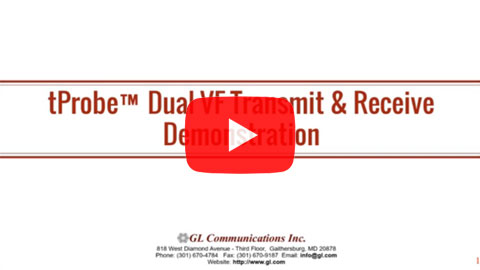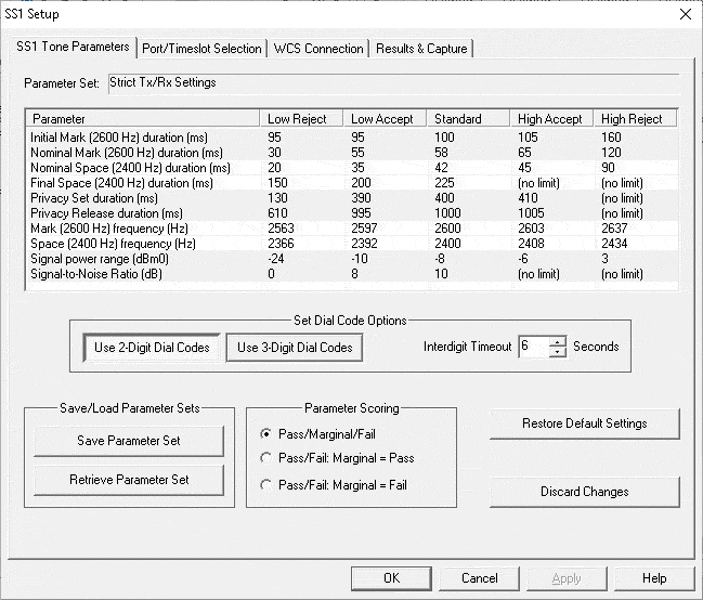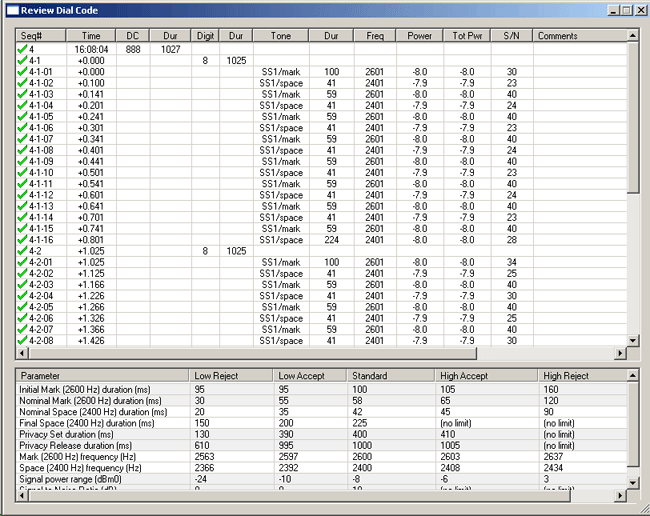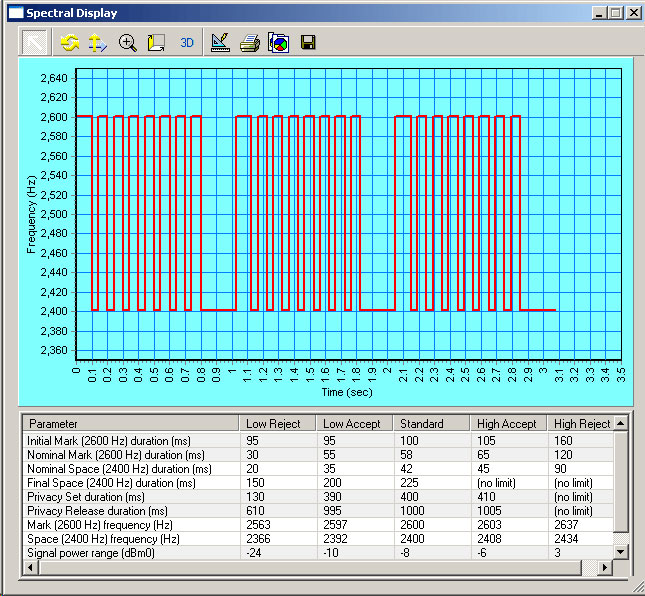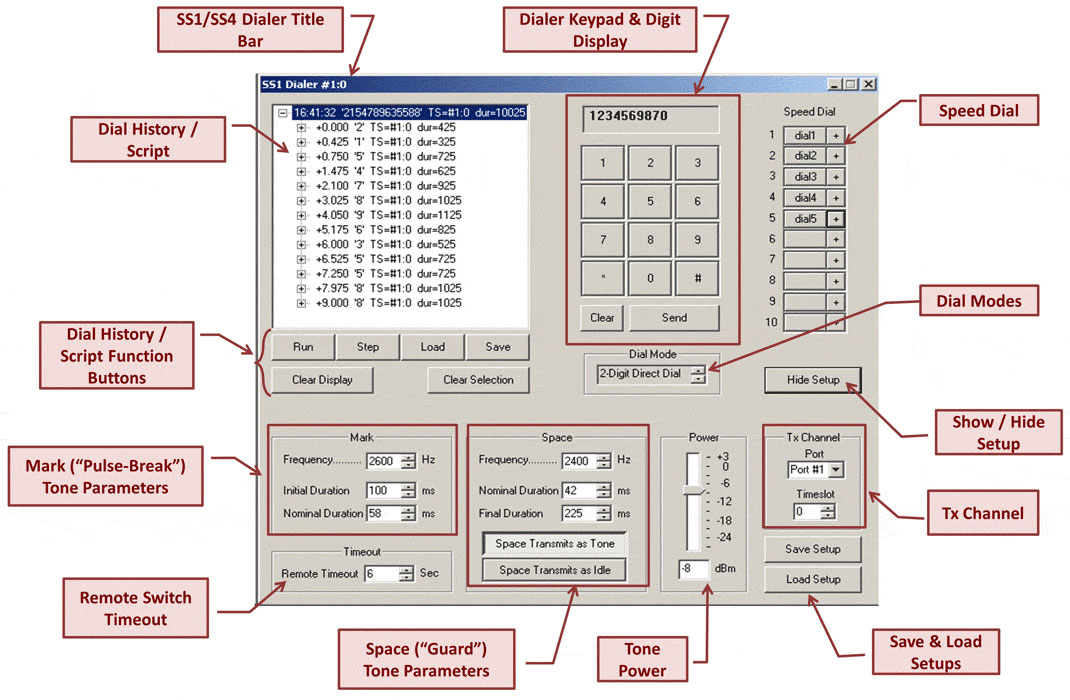Real-time & Remote SS1/SS4 Emulator and Analyzer
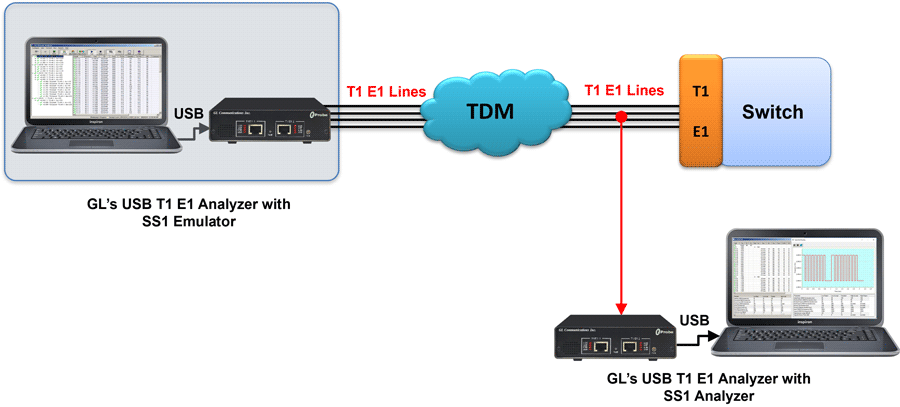
Overview
Selective Signaling "SS1/SS4" are 2 and/or 3-digit dial systems used by the Federal Aviation Administration (FAA) within their National Airspace System (NAS) Ground-to-Ground Air Traffic Control Network. It is used on leased and FAA lines between the Air Route Traffic Control Center's (ARTCC), Terminal Radar Approach Control (TRACON), Air Traffic Control Tower's (ATCT), Lockheed Martin Flight Service Hub's "FS-21", Military, National Weather Service and non-governmental aviation facilities for the control and management of aircraft flights.
The GL's SS1/SS4 analyzer detects and analyzes tone sequences that make up SS1/SS4 dial digits. Sequences of pulse and guard tones are detected, decoded, and assembled into their corresponding dial digits. The tone sequences are also verified for compliance against a "specification" parameter file which can correspond to published standards or user criteria.
The SS1/SS4 Emulator (Dialer) application provides the ability to setup and dial tone sequences that make up SS1/SS4 dial digits. The applications' interface includes options to setup dial code, and control mask (pulse) & space (guard) frequencies and duration, Initial, Nominal, and Final Durations, Timeout definitions, Transmit Channel, and other similar parameters related to the dial code.
Main Features
- Real-time and Offline (File-based) analysis using SS1/SS4 Analyzer
- Generate and introduce SS1/SS4 dial codes on transmit channels using SS1/SS4 dialer
- Control mark & space frequencies duration, and power during transmission of SS1/SS4 tones
- Dual monitoring capability allowing multiple instances of SS1/SS4 analyzer to simultaneously tap East and West direction traffic
- Ability to capture either TDM or audio signals
- Configuration screens let you to conveniently specify the criteria used to evaluate the sequence of SS1/SS4 tones, including specifying the use of 2-digit or 3-digit dial codes
- Display the received dial codes, including the characteristics of the underlying tones
- Provides controls to save sets of evaluation criteria, to reinstate previously saved criteria, and to reinstate factory default (industry standard) settings
- Save results to files in a form that is widely understood by popular desktop data management and analysis tools such as Microsoft® Access and Microsoft® Excel
- Allows easy reviewing any number of selected dial code sequences and their underlying tone sequences while ongoing capture and analysis is proceeding
- Operates the SS1/SS4 analyzer either remotely from the data acquisition site, or as on the same PC that is capturing the data
- Spectral Graph feature presents a captured dial code as a graphical waveform
Specifying SS1/SS4 Evaluation Parameters
The SS1/SS4 analyzer implements a wider range of values, which place lower and upper bounds on the FAIL range. Measurements falling outside this range disqualify a signal from being an SS1/SS4 Signaling Tone.
The values are organized as follows:
- Standard: The standard value of the parameter
- Low Accept through High Accept: Measurements within this range are judged to PASS the evaluation criteria
- Low Reject through High Reject: Measurements within this range but outside the Low Accept to High Accept range are judged to be MARGINAL
Parameter Scoring Options
- Pass/Marginal/Fail option - evaluates tones and their associated digits and dial codes records as PASS, MARGINAL, or FAIL
- Pass/Fail: Marginal=Pass option causes all MARGINAL scores to be reported as PASSes
- Pass/Fail: Marginal=Fail option causes all MARGINAL scores to be reported as FAILures
Real-time Analysis
Using GL's T1 Cards, one can internally capture signal data on a TDM channel or "timeslot". However, GL's T1 Cards also provide VF Input and Output jacks through which can insert an audio signal onto a designated T1 timeslot. If the SS1/SS4 signals are being carried on an audio line, route that line into the VF input associated with the T1 port, and then perform analysis.
For Offline analysis, SS1/SS4 analyzer allows users to specify the folder containing the files for SS1/SS4 analysis. File formats supported are a-law, u-law and pcm files.
The left pane (Tree View) shows the SS1/SS4 dial codes detected during a monitoring run displayed in protocol tree form. Each dial code can be "expanded" to show the digits at the next lower level of the protocol. The digits can in turn be expanded to show the sequence of tones making up the digit at the bottom level of the hierarchy. The right pane (Tone View) shows the elementary SS1/SS4 tones that make underlie the dial codes shown in the tree view.
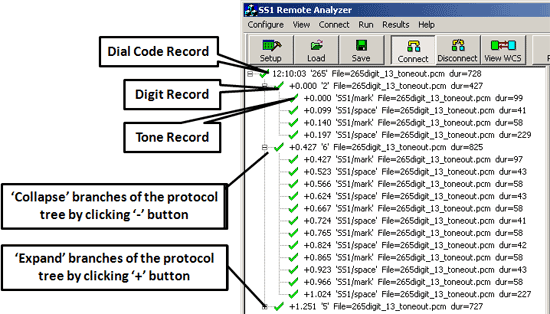
Analysis Results - Tree View
File-Based Analysis
In offline analysis, SS1/SS4 analyzer allows users to specify the folder containing the files for SS1/SS4 analysis. File formats supported are a-law, u-law and pcm files
- Analyze all files in a folder with a given file name extension or Analyze a specific file
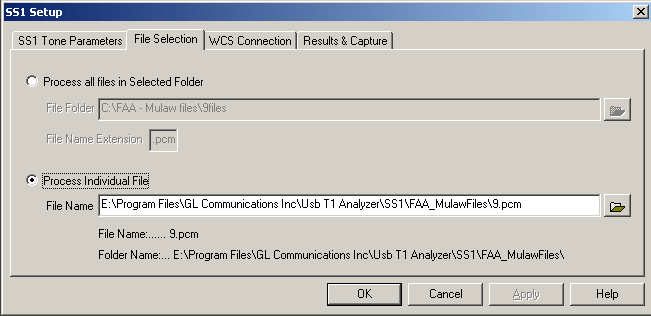
File Selection
WCS Connections
SS1/SS4 Protocol Analyzer are client application and requires connecting to a T1 E1 server. This allows SS1/SS4 analyzer to be used locally or on a remote PC w/o actual T1 E1 hardware installation. Use the WCS Connection options to set all the information required to establish a connection with the WCS server and correctly correspond with it.
SS1/SS4 Analyzer and the WCS server connection options -
- Connect to server on This Machine option allows SS1/SS4 analyzer to run on the capture PC
- Connect to server on... option allows SS1/SS4 Analyzer to run on a remote PC
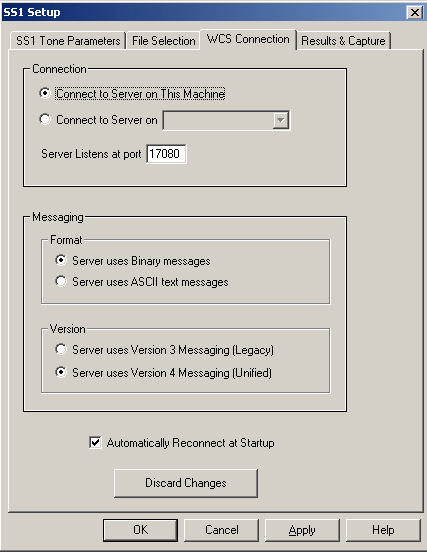
WCS Connection
Storage Options in Analyzer
Currently, the CSV file format is supported by on the SS1/SS4 analyzers. This format is widely recognized by popular Windows Data Management and analysis tools such as Microsoft® Excel and Microsoft® Access.
Table Name Prefix option allows users to designate a prefix for all files to be saved. The rest of the file name will be made up of a text indicating the date and time of capture, followed by a suffix distinguishing between dial code, digit, and tone records.
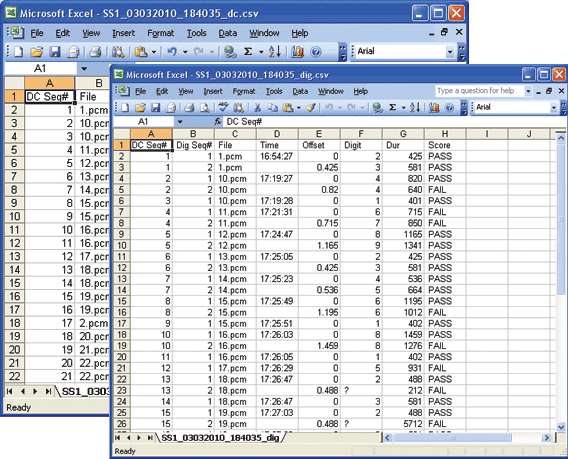
Dial Code & Digit Results in CSV files
Review Dial Code and Spectral Display Tools
It is quite likely that you will want to examine a faulty dial code at length, or view as a graphical waveform even as a run is in progress. The SS1/SS4 analyzer & dialer provides an independent Review Dial Code, and Spectral Display window options for this purpose.
SS1/SS4 Dialer
SS1/SS4 Dialing Digits (Dialer) application provides the ability to setup and dial tone sequences that make up SS1/SS4 dial digits. The application's interface includes options to setup Dial Code with control mask & space frequencies and duration, and other parameters related to the digit dialer. Users can create channel for Transmission (Tx), choosing Port and Timeslot.
Dial Modes
- Key & Send - All digits are transmitted back-to-back with only the final space tone separating the successive digits in a single burst
- 2-Digit Burst - When the second digit is pressed, the digits are transmitted back-to-back in a single burst. A "1" digit always triggers a transmission, even if it is not the last digit
- 3-Digit Burst - same as 2-Digit Burst Dial, but Dial Code contains three digits. When the third digit is pressed, the digits are transmitted back-to-back in a single burst
- 2-Digit Direct Dial - the Dial Code are sent one-by-one as you key them. When two digits have been keyed and transmitted, the Dial Code is transferred to the Dial History (Display)
- 3-Digit Direct Dial - same as 2-Digit Direct Dial, but Dial Code contains three digits. When three digits have been keyed and transmitted, the digit record is transferred to the dial code display
Resources
Note: PCs which include GL hardware/software require Intel or AMD processors for compliance.
Please Note: The XX in the Item No. refers to the hardware platform, listed at the bottom of the Buyer's Guide, which the software will be running on. Therefore, XX can either be ETA or EEA (Octal/Quad Boards), PTA or PEA (tProbe Units), XUT or XUE (Dual PCIe Express) depending upon the hardware.
| Item No. | Item Description |
| XX626 | SS1/SS4 Signaling Emulator and Analyzer |
| Related Hardware | |
|---|---|
| PTE001 | tProbe™ Dual T1 E1 Laptop Analyzer with Basic Analyzer Software |
| FTE001 ETE001 |
QuadXpress T1 E1 Main Board (Quad Port– requires additional licenses) OctalXpress T1 E1 Main Board plus Daughter Board (Octal Port– requires additional licenses) |
| XTE001 | Dual T1 E1 Express (PCIe) Boards (requires additional licenses) |
| TTE001 | tScan16™ Express Card |
 Back to Protocol Analysis Index Page
Back to Protocol Analysis Index Page
